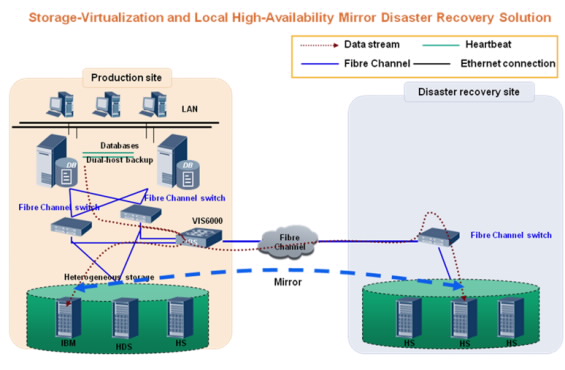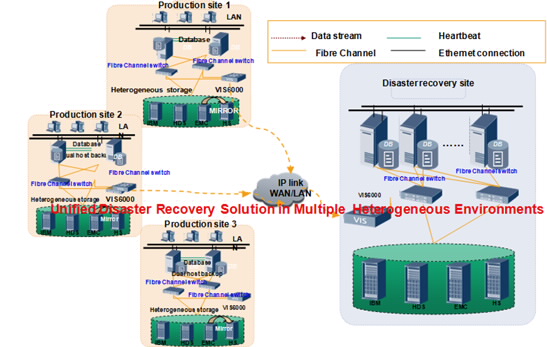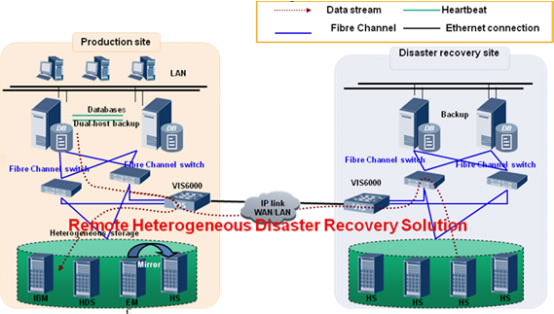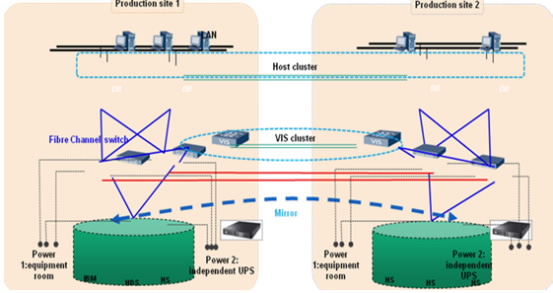The availability of IT systems determines their business continuity capability. High availability (HA) enables the fast failover of IT systems to protect the ongoing service or achieves the short mean time to repair (MTTR) required by the service level agreement (SLA). Therefore, HA is of great importance to storage systems in data centers. However, enterprises confront a series of challenges in disaster recovery.
- Multiple hosts share one storage system. Although applications can be switched among hosts without service interruption, data is not redundant, and a failure in the storage system will shut down the whole business system. To eliminate single points of failure and ensure business continuity, a full-redundancy business system with dual storage systems is recommended.
- Customers' data is scattered, storage systems are heterogeneous, and multiple branches exist in enterprises. Therefore, how to plan a unified disaster recovery platform is a great challenge. A comprehensive disaster recovery management function is required to improve operation and maintenance (O&M) efficiency and lower the maintenance cost.
- Enterprises often adopt replication technologies provided by traditional storage systems. However, replication technologies of different vendors are incompatible.
- A disaster recovery center is useful only when disasters happen. When there is no disaster, the center becomes useless, resulting in a waste of resources.
- Application-level disaster recovery is designed according to different host platforms and application system software. Therefore, the business system is complicated and the cost is high.
HUAWEI OceanStor VIS6000 is an industry-leading storage virtualization engine. It protects customers' key applications and data using different methods, including mirror protection to data among heterogeneous storage systems, data synchronization between two data centers in the same city, and replication among remote sites. There are three typical HUAWEI OceanStor VIS6000 solutions.
Storage-Virtualization and Local High-Availability Mirror Disaster Recovery Solution
Based on HUAWEI OceanStor VIS6000, the solution provides mirror protection to data of storage systems and uses the host clustering technology. It has a full-redundancy architecture and delivers HA local disaster recovery. Data is simultaneously written to dual storage systems. If one storage system is faulty, the access path to the data is switched over to the other storage system. The solution is applicable to business posing high requirements on real-time disaster recovery. The disaster recovery sites can locate at the same equipment room, adjoining buildings, or areas of the same city.

Torage-Virtualization Remote Disaster Recovery Solution
Based on HUAWEI OceanStor VIS6000, the solution adopts storage virtualization technology to be compatible with differences of heterogeneous storage systems and to integrate these storage systems to a resource pool. Furthermore, the solution reduces bandwidth used for replication and minimizes the recovery point object (RPO). Finally, by adopting comprehensive platforms for disaster recovery management, the solution provides flexible storage recovery strategies to help enterprises achieve point-to-point, multipoint-to-point, and two-area with three-center disaster recovery applications.


Storage-Virtualization Disaster Recovery Solution for Two Data Centers in the Same City
Base on HUAWEI OceanStor VIS6000, the disaster recovery solution for two data centers in the same city adopts scale-out and mirror functions of distributed clusters to share data between two data centers. Services can be switched to the other data center when one data center has disasters. The RPO and recovery time object (RTO) of the application-level disaster recovery are both zero.





